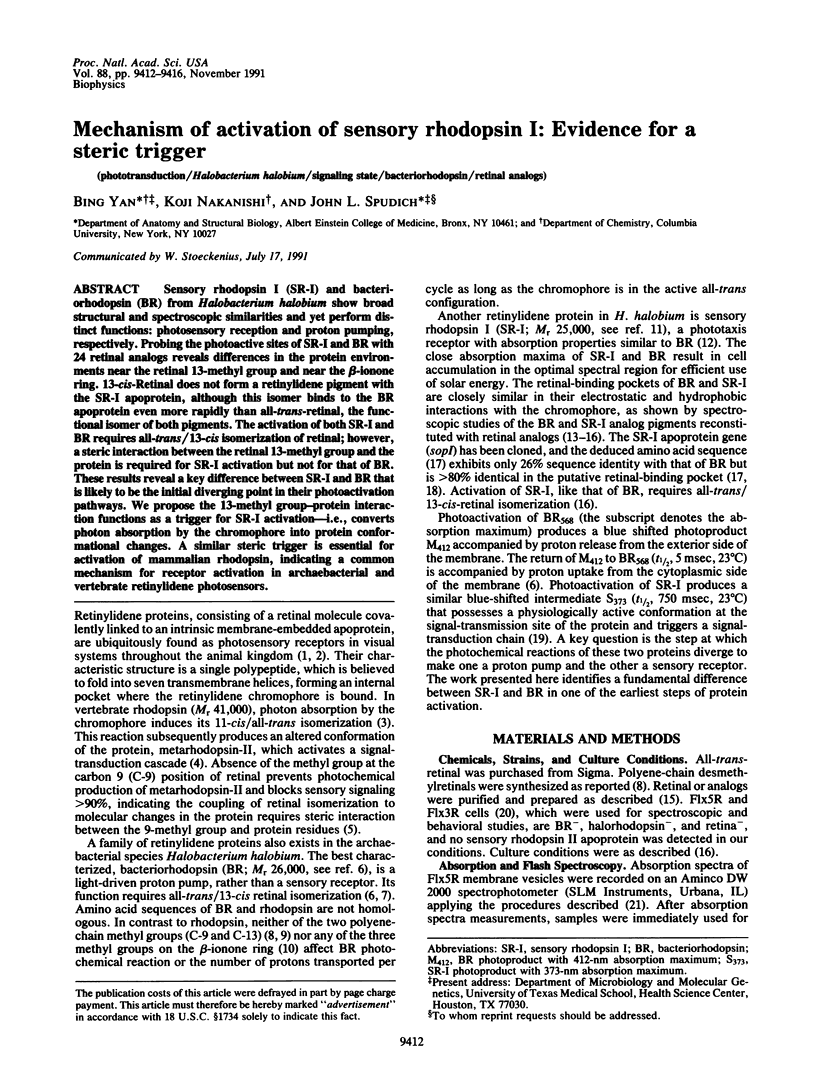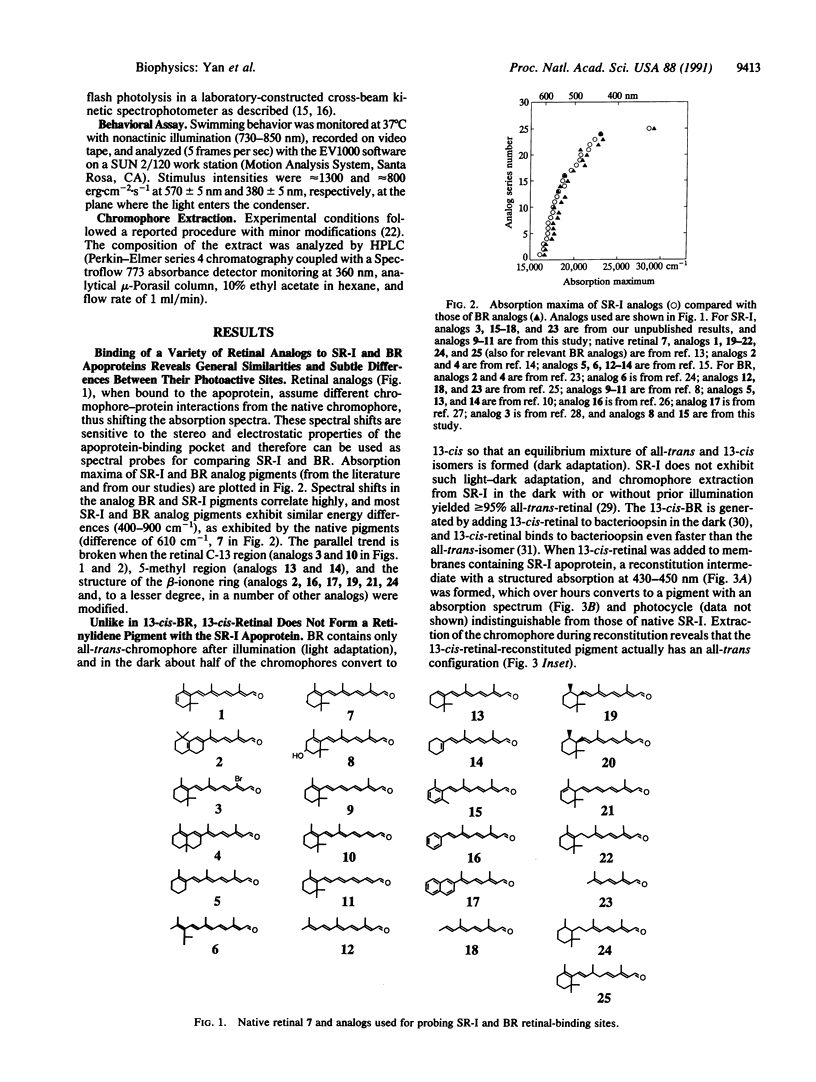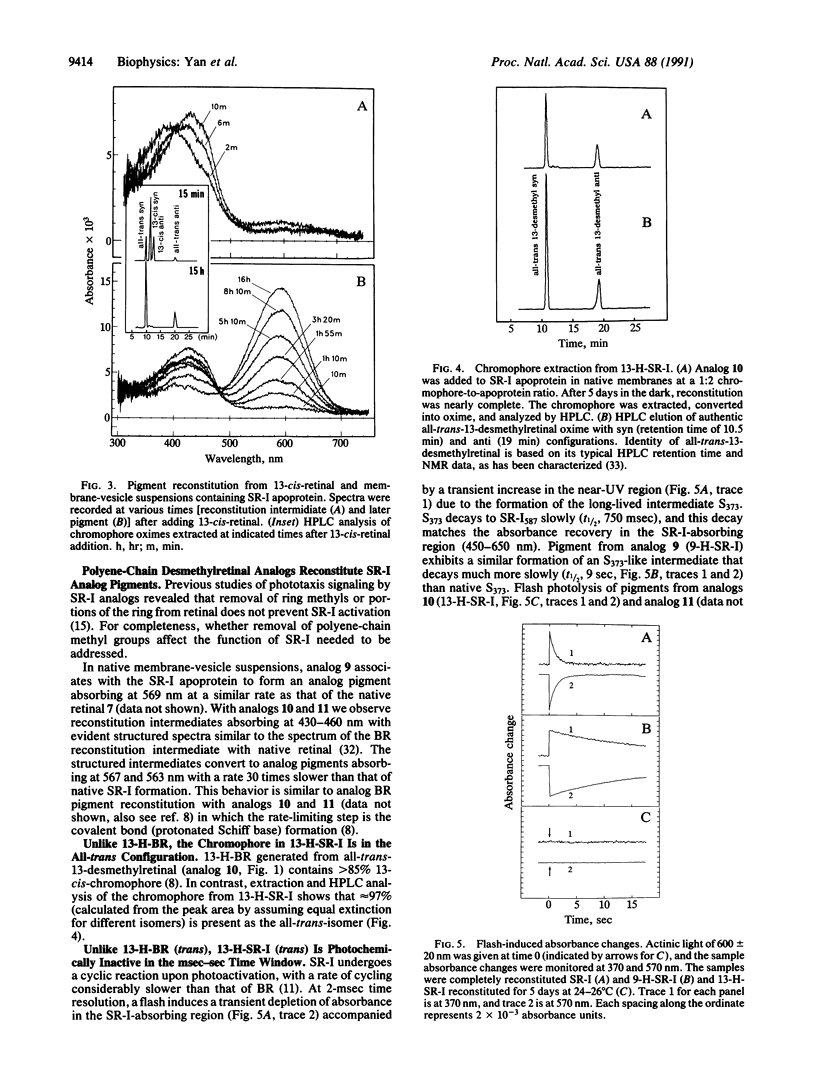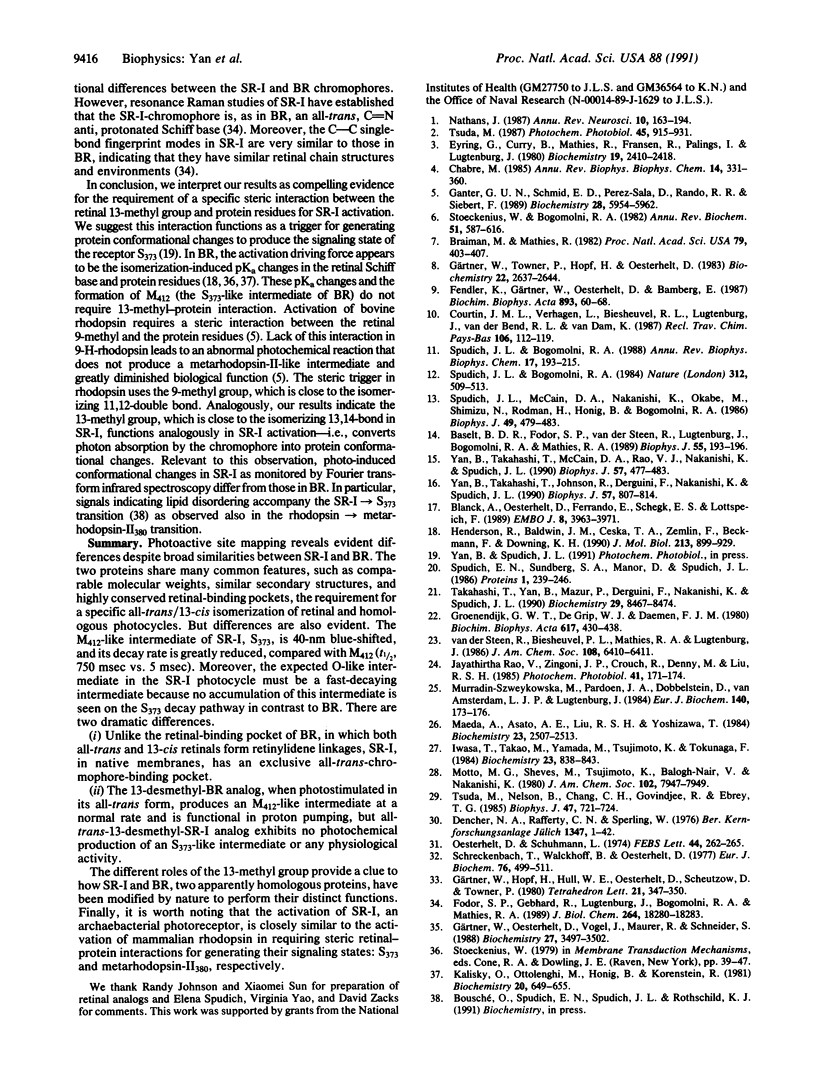Abstract
Sensory rhodopsin I (SR-I) and bacteriorhodopsin (BR) from Halobacterium halobium show broad structural and spectroscopic similarities and yet perform distinct functions: photosensory reception and proton pumping, respectively. Probing the photoactive sites of SR-I and BR with 24 retinal analogs reveals differences in the protein environments near the retinal 13-methyl group and near the beta-ionone ring. 13-cis-Retinal does not form a retinylidene pigment with the SR-I apoprotein, although this isomer binds to the BR apoprotein even more rapidly than all-trans-retinal, the functional isomer of both pigments. The activation of both SR-I and BR requires all-trans/13-cis isomerization of retinal;however, a steric interaction between the retinal 13-methyl group and the protein is required for SR-I activation but not for that of BR. These results reveal a key difference between SR-I and BR that is likely to be the initial diverging point in their photoactivation pathways. We propose the 13-methyl group-protein interaction functions as a trigger for SR-I activation--i.e., converts photon absorption by the chromophore into protein conformational changes. A similar steric trigger is essential for activation of mammalian rhodopsin, indicating a common mechanism for receptor activation in archaebacterial and vertebrate retinylidene photosensors.
Full text
PDF




Selected References
These references are in PubMed. This may not be the complete list of references from this article.
- Baselt D. R., Fodor S. P., van der Steen R., Lugtenburg J., Bogomolni R. A., Mathies R. A. Halorhodopsin and sensory rhodopsin contain a C6-C7 s-trans retinal chromophore. Biophys J. 1989 Jan;55(1):193–196. doi: 10.1016/S0006-3495(89)82791-2. [DOI] [PMC free article] [PubMed] [Google Scholar]
- Blanck A., Oesterhelt D., Ferrando E., Schegk E. S., Lottspeich F. Primary structure of sensory rhodopsin I, a prokaryotic photoreceptor. EMBO J. 1989 Dec 20;8(13):3963–3971. doi: 10.1002/j.1460-2075.1989.tb08579.x. [DOI] [PMC free article] [PubMed] [Google Scholar]
- Braiman M., Mathies R. Resonance Raman spectra of bacteriorhodopsin's primary photoproduct: evidence for a distorted 13-cis retinal chromophore. Proc Natl Acad Sci U S A. 1982 Jan;79(2):403–407. doi: 10.1073/pnas.79.2.403. [DOI] [PMC free article] [PubMed] [Google Scholar]
- Chabre M. Trigger and amplification mechanisms in visual phototransduction. Annu Rev Biophys Biophys Chem. 1985;14:331–360. doi: 10.1146/annurev.bb.14.060185.001555. [DOI] [PubMed] [Google Scholar]
- Eyring G., Curry B., Mathies R., Fransen R., Palings I., Lugtenburg J. Interpretation of the resonance Raman spectrum of bathorhodopsin based on visual pigment analogues. Biochemistry. 1980 May 27;19(11):2410–2418. doi: 10.1021/bi00552a020. [DOI] [PubMed] [Google Scholar]
- Fodor S. P., Gebhard R., Lugtenburg J., Bogomolni R. A., Mathies R. A. Structure of the retinal chromophore in sensory rhodopsin I from resonance Raman spectroscopy. J Biol Chem. 1989 Nov 5;264(31):18280–18283. [PubMed] [Google Scholar]
- Ganter U. M., Schmid E. D., Perez-Sala D., Rando R. R., Siebert F. Removal of the 9-methyl group of retinal inhibits signal transduction in the visual process. A Fourier transform infrared and biochemical investigation. Biochemistry. 1989 Jul 11;28(14):5954–5962. doi: 10.1021/bi00440a036. [DOI] [PubMed] [Google Scholar]
- Groenendijk G. W., De Grip W. J., Daemen F. J. Quantitative determination of retinals with complete retention of their geometric configuration. Biochim Biophys Acta. 1980 Mar 21;617(3):430–438. doi: 10.1016/0005-2760(80)90009-0. [DOI] [PubMed] [Google Scholar]
- Henderson R., Baldwin J. M., Ceska T. A., Zemlin F., Beckmann E., Downing K. H. Model for the structure of bacteriorhodopsin based on high-resolution electron cryo-microscopy. J Mol Biol. 1990 Jun 20;213(4):899–929. doi: 10.1016/S0022-2836(05)80271-2. [DOI] [PubMed] [Google Scholar]
- Kalisky O., Ottolenghi M., Honig B., Korenstein R. Environmental effects on formation and photoreaction of the M412 photoproduct of bacteriorhodopsin: implications for the mechanism of proton pumping. Biochemistry. 1981 Feb 3;20(3):649–655. doi: 10.1021/bi00506a031. [DOI] [PubMed] [Google Scholar]
- Maeda A., Asato A. E., Liu R. S., Yoshizawa T. Interaction of aromatic retinal analogues with apopurple membranes of Halobacterium halobium. Biochemistry. 1984 May 22;23(11):2507–2513. doi: 10.1021/bi00306a029. [DOI] [PubMed] [Google Scholar]
- Muradin-Szweykowska M., Pardoen J. A., Dobbelstein D., Van Amsterdam L. J., Lugtenburg J. Bacteriorhodopsins with chromophores modified at the beta-ionone site. Formation and light-driven action of the proton pump. Eur J Biochem. 1984 Apr 2;140(1):173–176. doi: 10.1111/j.1432-1033.1984.tb08082.x. [DOI] [PubMed] [Google Scholar]
- Nathans J. Molecular biology of visual pigments. Annu Rev Neurosci. 1987;10:163–194. doi: 10.1146/annurev.ne.10.030187.001115. [DOI] [PubMed] [Google Scholar]
- Oesterhelt D., Schuhmann L. Reconstitution of bacteriorhodopsin. FEBS Lett. 1974 Aug 30;44(3):262–265. doi: 10.1016/0014-5793(74)81153-1. [DOI] [PubMed] [Google Scholar]
- Rao V. J., Zingoni J. P., Crouch R., Denny M., Liu R. S. Isomers of 3,7,11-trimethyldodeca-2,4,6,8,10-pentaenal (a linear analogue of retinal) and lower homologues in their interaction with bovine opsin and bacterioopsin. Photochem Photobiol. 1985 Feb;41(2):171–174. doi: 10.1111/j.1751-1097.1985.tb03467.x. [DOI] [PubMed] [Google Scholar]
- Schreckenbach T., Walckhoff B., Oesterhelt D. Studies on the retinal-protein interaction in bacteriorhodopsin. Eur J Biochem. 1977 Jun 15;76(2):499–511. doi: 10.1111/j.1432-1033.1977.tb11620.x. [DOI] [PubMed] [Google Scholar]
- Spudich E. N., Sundberg S. A., Manor D., Spudich J. L. Properties of a second sensory receptor protein in Halobacterium halobium phototaxis. Proteins. 1986 Nov;1(3):239–246. doi: 10.1002/prot.340010306. [DOI] [PubMed] [Google Scholar]
- Spudich J. L., Bogomolni R. A. Mechanism of colour discrimination by a bacterial sensory rhodopsin. Nature. 1984 Dec 6;312(5994):509–513. doi: 10.1038/312509a0. [DOI] [PMC free article] [PubMed] [Google Scholar]
- Spudich J. L., Bogomolni R. A. Sensory rhodopsins of halobacteria. Annu Rev Biophys Biophys Chem. 1988;17:193–215. doi: 10.1146/annurev.bb.17.060188.001205. [DOI] [PubMed] [Google Scholar]
- Spudich J. L., McCain D. A., Nakanishi K., Okabe M., Shimizu N., Rodman H., Honig B., Bogomolni R. A. Chromophore/protein interaction in bacterial sensory rhodopsin and bacteriorhodopsin. Biophys J. 1986 Feb;49(2):479–483. doi: 10.1016/S0006-3495(86)83657-8. [DOI] [PMC free article] [PubMed] [Google Scholar]
- Stoeckenius W. A model for the function of bacteriorhodopsin. Soc Gen Physiol Ser. 1979;33:39–47. [PubMed] [Google Scholar]
- Stoeckenius W., Bogomolni R. A. Bacteriorhodopsin and related pigments of halobacteria. Annu Rev Biochem. 1982;51:587–616. doi: 10.1146/annurev.bi.51.070182.003103. [DOI] [PubMed] [Google Scholar]
- Takahashi T., Yan B., Mazur P., Derguini F., Nakanishi K., Spudich J. L. Color regulation in the archaebacterial phototaxis receptor phoborhodopsin (sensory rhodopsin II). Biochemistry. 1990 Sep 11;29(36):8467–8474. doi: 10.1021/bi00488a038. [DOI] [PubMed] [Google Scholar]
- Tsuda M., Nelson B., Chang C. H., Govindjee R., Ebrey T. G. Characterization of the chromophore of the third rhodopsin-like pigment of Halobacterium halobium and its photoproduct. Biophys J. 1985 May;47(5):721–724. doi: 10.1016/S0006-3495(85)83969-2. [DOI] [PMC free article] [PubMed] [Google Scholar]
- Yan B., Takahashi T., Johnson R., Derguini F., Nakanishi K., Spudich J. L. All-trans/13-cis isomerization of retinal is required for phototaxis signaling by sensory rhodopsins in Halobacterium halobium. Biophys J. 1990 Apr;57(4):807–814. doi: 10.1016/S0006-3495(90)82600-X. [DOI] [PMC free article] [PubMed] [Google Scholar]
- Yan B., Takahashi T., McCain D. A., Rao V. J., Nakanishi K., Spudich J. L. Effects of modifications of the retinal beta-ionone ring on archaebacterial sensory rhodopsin I. Biophys J. 1990 Mar;57(3):477–483. doi: 10.1016/S0006-3495(90)82564-9. [DOI] [PMC free article] [PubMed] [Google Scholar]


